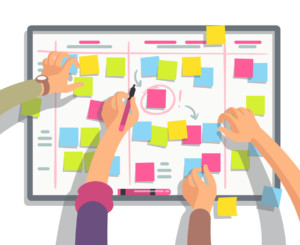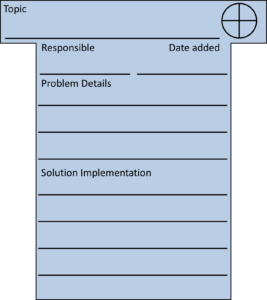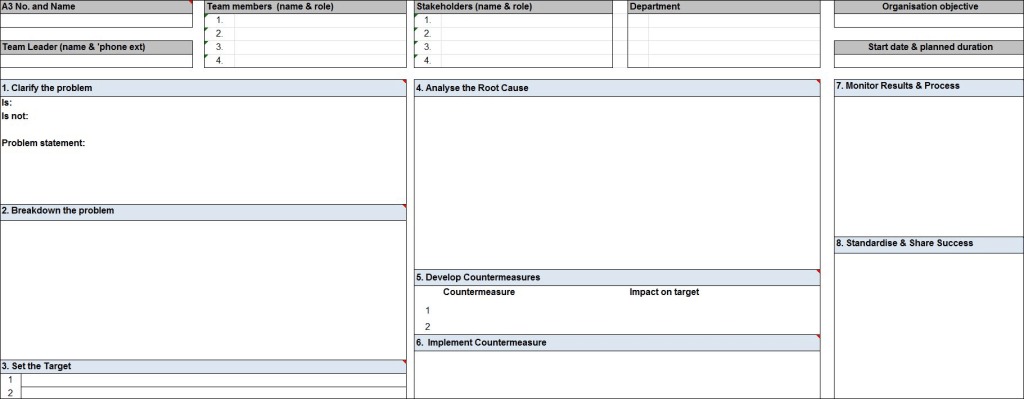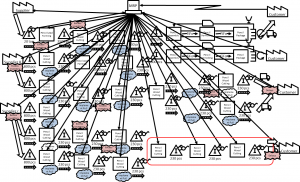 In my second post in this series on shop floor management I will look at more things that go into the team corner besides the tracked KPI. How do you manage your improvement activities? What organizational stuff should go in there? Hopefully this will help you make more successful shop floor meetings. In my next post I will also talk about what should NOT go into a team corner on the shop floor.
In my second post in this series on shop floor management I will look at more things that go into the team corner besides the tracked KPI. How do you manage your improvement activities? What organizational stuff should go in there? Hopefully this will help you make more successful shop floor meetings. In my next post I will also talk about what should NOT go into a team corner on the shop floor.
Improvement Management
 Another common section in the shop floor meeting corner (or team corner) is for improvement. This section contains a list of problems that have happened and are worked on. There are two common approaches. The first one is to have a table, with a line for every issue. The second one uses some sort of cards, with one card per problem. I usually prefer the cards since they can be moved around easily. The top priority goes to the … well … top. Lower priorities are moved down. A completed card is archived.
Another common section in the shop floor meeting corner (or team corner) is for improvement. This section contains a list of problems that have happened and are worked on. There are two common approaches. The first one is to have a table, with a line for every issue. The second one uses some sort of cards, with one card per problem. I usually prefer the cards since they can be moved around easily. The top priority goes to the … well … top. Lower priorities are moved down. A completed card is archived.
 Some companies use T-Cards, which are cards shaped like a T, so they can be inserted in slotted boards, but without falling too deep into the slots due to the “T”-bar. Others use some sort of Post-its, although you have to make sure that they do not fall off easily.
Some companies use T-Cards, which are cards shaped like a T, so they can be inserted in slotted boards, but without falling too deep into the slots due to the “T”-bar. Others use some sort of Post-its, although you have to make sure that they do not fall off easily.
If you are using a table to track your improvements, however, you eventually will end up with lots of completed entries, and only a few open ones, with more on the next sheet. This requires some searching to find out what is still ongoing and what not.
Regardless if you use a table or a separate set of cards, the structures are very similar. It is in effect a micro-version of the A3 report. There is a brief description of the problem, and a suggested set of solutions and/or measures. A check if the implementation works is also highly suggested, but just like the PDCA often forgotten. Frequently there is also a field for the person responsible for this issue and the date it was added. Finally, the PDCA circle is often also shown. This is a circle divided into quadrants. Whenever a quadrant is completed, the quadrant is filled out. This is an easy tool for visual management to see how far the problem solving process has advanced. Often, variants are found that slightly deviate from the PDCA, but I like to stick to the PDCA.
In all likelihood you may have more issues than you and your team can solve in a reasonable time. Do NOT make the mistake of putting all topics on your to-do list of topics to be resolved. Instead, keep a separate backlog of open problems. If you try to attack all problems at the same time, you are like the young tiger that wants to catch all ducks at the same time … you will end up with none.
If you have larger improvement projects going on, you can also add some info on the larger projects. For example, you could hang up the A3 report (original or copy) for ongoing projects.

Organizational Stuff
Often, the team corners also contain organizational elements.
Worker Assignment and Absence

One possibility is to add an overview of the workers in this section, which ones are in/out today, and where they are working. This can be combined with a qualification matrix, showing which worker is trained on which processes. If you track your workers’ attendance, make sure that you do not go into too much detail unless the workers agree. If you make it publicly visible who was sick on which days, then a lot of workers would feel unhappy, morale would go down, and you may be heading for trouble with the unions. This is usually not worth the benefit. Find a trade-off between worker-related data that you need on the team corners rather than just on file, and the happiness of the workers about not being put on display.
Contacts
 Sometimes there is also a small note about who is in charge of this team corner. This may also include a corporate mobile number. Often, additional contacts are also listed, for example the names and photos of the first responders (employees with additional first-aid training) in case of an emergency. You always hope that you never need this, but if you do, you will be glad that you have. Including the photos in the team corner also helps the employees to memorize this. In an emergency, they know who to reach out without having to look it up first.
Sometimes there is also a small note about who is in charge of this team corner. This may also include a corporate mobile number. Often, additional contacts are also listed, for example the names and photos of the first responders (employees with additional first-aid training) in case of an emergency. You always hope that you never need this, but if you do, you will be glad that you have. Including the photos in the team corner also helps the employees to memorize this. In an emergency, they know who to reach out without having to look it up first.
Participants

Yet another element of a team corner is often a list of participants for the team meeting. This can include the workers and foremen that are covered by this team corner, although this is usually not really that helpful. More helpful is tracking the participation of other employees that usually do not belong to the team corner. In many companies, a representative of logistics or engineering may be present during at least some of the meetings.
In some plants, even managers up to the plant manager are scheduled to attend such team meetings. Naturally, a plant manager cannot attend every meeting every time, but he could have to attend at least one meeting per week. This helps the managers to get a grasp of what is really going on on the shop floor.
Often such an attendance is tracked in a simple table, with a row for each name, and a column for the days of the months. Additionally, there may be a note if attendance is not required every time but weekly or monthly. Filling out a day in green means this person attended, yellow means it was an absence but with prior excuse, and red means the person was missing without prior explanation. If the person is scheduled to attend less than daily, you can fill out the entire period if that person attended at least once. Maybe mark the actual day of attendance.
Of course, tracking the time of your bosses can land you in hot water if your boss did not give you permission for this. I have seen such manager attendance tracking a few times, but it always started with a suggestion from the top. I also strongly recommend not tracking the attendance of your boss unless your boss wants to be tracked … or your boss’s boss tells your boss that he should be tracked.
Checklists or To-Do Lists
 Not always but in some cases you can find checklists on the team corner. If there are a number of steps that have to be done regularly AND should be checked in the team meeting, then you may add such a checklist. Examples would be some maintenance, sending of a report, or similar. A check mark or name can be added for every entry and the corresponding day to see if it was actually done. But please only use this on the team corner if necessary, not only because you can. The team meeting is probably already full of topics, and adding more will delay everything else.
Not always but in some cases you can find checklists on the team corner. If there are a number of steps that have to be done regularly AND should be checked in the team meeting, then you may add such a checklist. Examples would be some maintenance, sending of a report, or similar. A check mark or name can be added for every entry and the corresponding day to see if it was actually done. But please only use this on the team corner if necessary, not only because you can. The team meeting is probably already full of topics, and adding more will delay everything else.
General Info
The team corner also frequently can contain additional information that is relevant. It could be printouts of general announcements, or info on upcoming changes, or a message from your unions, or … or … or. I am sure you can think of a lot of things in your plant. Just don’t overdo it. The space in the team corner is limited, and you won’t be able to fit everything on it that somebody would like to add.
Not Necessary
There are a few more things that are sometimes found in team corners, but in my view are completely not necessary.
Value Stream Map and Layouts
 Many Western lean companies love to do value stream maps. They do have their uses, but are in my view widely overused in Western companies. I see them as a tool for specific projects, and not as an “always on” KPI. Besides, the people that are usually in the team corner know their value stream probably better than anyone.
Many Western lean companies love to do value stream maps. They do have their uses, but are in my view widely overused in Western companies. I see them as a tool for specific projects, and not as an “always on” KPI. Besides, the people that are usually in the team corner know their value stream probably better than anyone.
Similar applies to layouts. They are only helpful for certain types of improvement projects, or for people unfamiliar with the area to get an understanding. But again, the people in the team corner know their area better than anyone else.
Mission Statements

Company executives love to have mission statements. Unfortunately, these mission statements often live in a parallel world disconnected from reality. Often, they are a collection of fancy modern management buzzwords. It is full of “aspirations,” “strive,” “exceptional,” and “achieve.” They talk about “global strategy” and “leadership,” and occasionally also the “customer.”
If it is a good mission statement aligned with how the company really is (not how the CEO wants it to be), the workers will ignore it. If it is a bad mission statement, it will be ridiculed. Overall, it is a waste of space in the team corner. Hang it somewhere else where it is not in the way.
However, if there is truly something praiseworthy and connected to this section of the shop floor, feel free to hang it up. If there was an award for quality or performance in this section, put it up in their team corner. It is fine to have motivational items in the team corner, if it means something to the team.
This wraps up the design of the team corner. In my next post I will talk about how to actually conduct a shop floor team meeting as part of the shop floor management. Until then, go out, prepare your whiteboards, and organize your industry!

